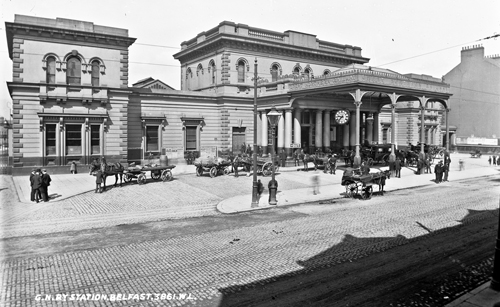Railway companies raise concerns about Civil war costs, high wages and railway system changes
Dublin, 28 February 1923 - The issues of mounting costs to the railways from ongoing disturbances and future organisation of the Irish railway system post partition were to the fore yesterday when various railway companies held their annual meetings.
Addressing his company’s annual meeting in Dublin, the Chairman of the great Northern Railway Company (Ireland) Mr. William P. Cairnes, put the cost of conducting business under conditions which saw hundreds of cases of illegal interference and extensive damage to bridges, buildings, rolling stock and other equipment at £39,000.
Other railway companies have experienced similar losses for damage and destruction. The damage that resulted in claims on the south-eastern line, reported by the Dublin and South-Eastern Railway Company, amounted to £32,078 by the end of December. Overall to date, the cost of the damage is estimated at £80,000.

A passenger train was set on fire and destroyed near Killiney train station - the passenger train, seen here ablaze at night, served the Dublin to Bray line (Image: The Illustrated London News, 10 February 1923)
From the South, the news was even worse. The Chairman of the Cork and Macroom Railway John Harding reported that the line had been closed since August 1922. In addition to the disruption and damage to revenues from Civil War-related attacks and disturbances, the various railway management have highlighted their concerns around high wages in the industry. Independent Senator Sir Thomas Esmonde, reporting to the ordinary general meeting of the Dublin and South-East Railway Co., claimed that wages absorbed 50.76% of gross receipts last year as opposed to 28% in 1913. The Company claims that the wages bill in 1922 was 216% greater than that of 1913 and rates of wages were being maintained at the direction of the Government.
On the issue of railway organisation, the annual meeting of the Great Northern Railway was informed that the Free State had given the company three months from January 1st last to put forward an agreed scheme for grouping the railways, after which the Government would proceed with its own preferred policy of unification.
The railways had nevertheless decided that the grouping was preferable to unification and that the Irish railways were best divided into two systems, one for north and one for south - the line running from Dublin to Galway.
[Editor's note: This is an article from Century Ireland, a fortnightly online newspaper, written from the perspective of a journalist 100 years ago, based on news reports of the time.]





















